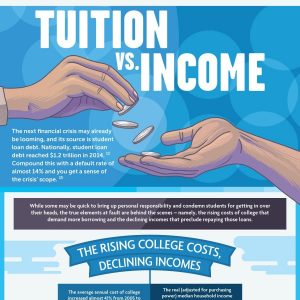
Tuition vs. Income
The next financial crisis may already be looming, and its source is student loan debt. Nationally, student loan debt reached $1.2 trillion in 2014. (1) Compound this with a default rate of almost 14% and you get a sense of the crisis’ scope. (2)
While some may be quick to bring up personal responsibility and condemn students for getting in over their heads, the true elements at fault are behind the scenes – namely, the rising costs of college that demand more borrowing and the declining incomes that preclude repaying those loans.
The Rising College Costs, Declining Incomes
The average annual cost of college increased almost 41% from 2005 to 2012: (2)
2004-05: $13,793
2005-06: $14,634
2006-07: $15,483
2007-08: $16,231
2008-09: $17,092
2009-10: $17,649
2010-11: $18,497
2011-12: $19,418
The real (adjusted for purchasing power) median household income in the United States fell almost 7% during that same period: (3)
2005: $56,160
2006: $56,598
2007: $57,357
2008: $55,313
2009: $54,925
2010: $53,507
2011: $52,690
2012: $52,650
The Growth of Student Loans
To keep pace with the rising cost of college and the decline of real income, more Americans have been borrowing more money to pay for school.
The percentage of enrolled students with loans rose 7 points – or almost 16% – from 2002 to 2013: (2)
2005: 44%
2006: 45%
2007: 44%
2008: 46%
2009: 47%
2010: 51%
2011: 50%
2012: 51%
The average student loan balance also rose almost 55% from 2005 to 2012: (4)
2005: $15,651
2006: $17,273
2007: $18,511
2008: $19,885
2009: $20,820
2010: $21,867
2011: $22,640
2012: $24,257
The Proliferation of Student Loan Defaults
Not only has the decline of real income forced Americans to borrow more to meet the rising costs of college, it has perversely made the repayment of those loans more difficult.
The percentage of borrowers under age 30 (that is, recent first-time borrowers) who are more than 90 days delinquent on their student loan payments has risen 2.5 points – or almost 68% – from 2005 to 2012: (4)
2005: 3.7%
2006: 3.8%
2007: 4.2%
2008: 4.8%
2009: 5.2%
2010: 5.8%
2011: 6.1%
2012: 6.2%
But Why is the Cost of College Rising?
1. Colleges raise their prices each time student loan limits are raised, creating an inflationary feedback loop. (5)
2. Measured in inflation-adjusted dollars, public funding for state universities, that educate the majority of Americans, fell 21% from 2000 to 2010: (6)
2000: $8,257 per pupil
2010: $6,532 per pupil
3. Not only has tuition increased, jumping 5% for in-state students at public universities from 2011 to 2012, but so too have housing and food costs, which increased 4% over the same time. (7)
Average estimated budget for in-state public university students 2015-16: (8)
Tuition and fees: $9,410
Room and board: $10,138
Books and supplies: $1,298
Transportation: $1,109
Other expenses: $2,106
Total: $24,061
Sources:
1. http://www.usatoday.com
2. http://nces.ed.gov
3. https://www.stlouisfed.org
4. https://www.newyorkfed.org
5. http://www.forbes.com
6. http://www.cbsnews.com
7. http://www.csmonitor.com
8. http://www.collegeboard.org

 The Best Colleges
The Best Colleges The Lowest Costs
The Lowest Costs The Highest Returns
The Highest Returns